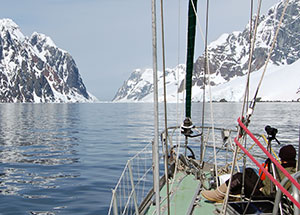
Anchors are right at the heart of cruising. They allow remote and wonderful places to be visited, without the benefit of a solid dock or even mooring buoy. Put that notion with the recent comments from yachts surviving (or not surviving as the case may be) the recent spate of hurricanes worldwide, and it is clear one of the most important pieces of equipment onboard is your anchor, and associated gear. In New Zealand, which the author calls home, a large number of visiting cruisers still carry the older generation anchors such as plows (CQR), Deltas, claws (Bruce), and Danforth types. These boaters may not be fully aware of the benefits of the newer generation type anchors now widely available – which have raised the bar significantly in expectations of anchoring performance. Cruising safely can be something of a numbers game, and ensuring you have the best anchor possible is one way to stack the odds in your favor.
“The faithful CQR plough anchor… during the first three tests at 5:1 scope it failed to set. No matter how slowly we went, or how much we tried to manually coax the anchor to set, it seemed to skip along the seabed. Even at 7:1 scope it failed to penetrate. It set and held briefly at 2,000 lb at our second location, but released instantly and didn’t re-set.” — Yachting Monthly, surprised by their results in their 2006 testing on hard Californian sand, and displaying considerable unscientific bias in favor of the CQR by trying to baby it, but still gaining only negative results. The Claw (Bruce copy) was even less impressive, exhibiting the classic claw ‘hop and skip’ behavior: “One of the worst performers in our tests. The maximum resistance at 5:1 scope was 886 lb – for a brief spike before breaking out. The tension graphs showed that the anchor never penetrated properly, setting and releasing rapidly or simply scraping the bottom… Similar results at 7:1 scope.”
The author must confess at this stage to being the designer of the Rocna, a new anchor design which began commercial life by receiving an excellent response from the international offshore fleet visiting New Zealand, and now has an established presence internationally. Rather than allow this article to deteriorate into an infomercial for a particular brand, the differences between the older and newer designs will be discussed in general. Most testing (and yes, it is accepted that anchors are very difficult to test properly, but there do exist some informative comparisons) shows a big improvement evident in the new generation, which only reinforces what more and more cruisers are seeing for themselves.
“… anchors which lie comfortably on a flat surface (principally the CQR and Danforth) are prone to skidding across the seabed and failing to find grip.” — Prof. John Knox considering the results of his own anchor testing for Practical Boat Owner. Knox also commented that “The Spade was the best performer for a given weight. It was roll-stable and held extremely well. It was also the most deeply buried anchor. The Delta… and Bruce… gave about 60% of the Spade’s hold.” This was before the Rocna was developed, and the Bügel was not tested.
Let’s discuss the common problems with the ‘old’ generation of anchors. Specifically, we are talking about: Danforth-style flat-fluke symmetrical types, plows (both CQRs and Deltas), and claws (Bruces). Practical Sailor has highlighted some of these issues repeatedly in their series of articles on anchoring, as has SAIL and Yachting Monthly, amongst others. The author’s personal experience (his yacht Kiwi Roa used to carry a 110 lb CQR, an 88 lb Delta, and a 110 lb Bruce) formed the primary incentive behind the development of the Rocna. Inherent problems with these now outdated anchor types include inconsistent setting performance (often not setting at all), poor holding in soft bottoms, and failure to penetrate in hard substrates. There are type-specific issues also, such as the moving parts of hinged-shank plows, which can cause injury to crew as well as reducing strength; blade shapes designed to furrow (i.e. plow) through the ground (CQRs and Deltas); and the “hopping and skipping” behavior of claws (Bruces), together with their tendency to skip along the bottom rather than reset.
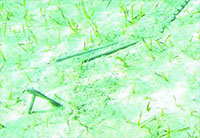
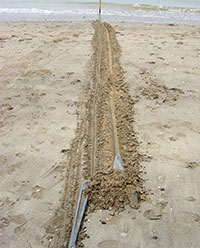
Inconsistent setting leads to unpredictably anchoring. Most anchors must be in a particular attitude (position and angle relative to the seabed) in order to set, and slight flaws in the design of the anchor lead to the attainment of this attitude being a hit-and-miss affair. The plow (particularly the articulating-shank CQR-type) is the worst offender. If a CQR, for example, lands with its fluke in an upright position, it will usually set without problems, but if the fluke (the actual plow part) lands on its side, with the shank rotated away, that anchor will be lucky to set at all. Commenting on the results of Danforth’s 1988 testing, Betsy Holman wrote “The 35-pound CQR alternatively bit and skipped along the bottom without getting a good hold. This would seem to be the nature of this anchor when it fails to bury.” On a hard bottom, it is not uncommon to drag a plow in this situation for 50 meters without a set – the only solution is to pick it up and try again, and hope that next time it lands on the seabed with the correct attitude.
Claws have a unique quirk in the form of hop-and-skip behavior. This is technically known as roll-stability (or lack of), and is seen when the anchor has a large amount of force applied to it. Any anchor, no matter how effective, will drag if you apply enough force to it, and its behavior beyond this point is particularly telling. The claw, once dragged beyond its yield, hops out of the ground, then skips along until it manages to dig in again. Unfortunately this process tends to continue since the boat, once dragging anchor, will tend to only gather speed, and the anchor becomes less and less likely to set once more. Why does it hop out in the first place? Because it is not roll-stable. Sand or mud tends to ‘ball’ in the anchor, and does not flow evenly past the flukes. This, combined with the huge amount of torque applied to the anchor as it starts to move through the substrate, trips it – and it rolls out. A graph of resistance, or holding power, over time, usually shows a steady increase as more and more force is applied (increasing wind or tide for example), then a sharp drop off (as the anchor lets go), followed by a series of peaks and dips as the anchor bites sporadically, only to fail again and again. Even if the peak holding power of the claw was good (it isn’t), this behavior is unacceptable.
“… much of their popularity derives from the ease with which they stow on the stemhead. But their performance proved disappointing… the Bruce anchor’s reputation was founded on it being used to anchor oilrigs but a Bruce of dozens of tons is a very different animal from the ones we tested. In gravel these claws bounce about whereas in sand they lie down on their side and rarely exceed 200 kg of holding power.” — Antoine Sézérat on the Bruce and its copies, writing for Voiles et Voiliers. He ranked the Delta “mid-field among the plows”, and also commented on Danforth-types. In short: “Tests show that their versatility does not put them on a par with the most radical plow anchors.” (Translated from original French)
Practical Sailor were quite explicit in their second round of testing, back in 1999. “Anchors that failed our 400-lb. minimum were the Bruce, Claw, Danforth…” they said. “Neither the Bruce, with an average holding power of 307 lbs, nor the Claw, which held to an average of 283 lbs, did anything to alter their reputations.” Poor holding power is the single most obvious potential issue with any anchor. (As an aside, although holding power is the ultimate factor, it is not the only one. An anchor with excellent holding power that never sets is of no use to anyone). Holding, or stopping, power mostly relates to a function of fluke surface area and configuration. All the old generation designs suffer from a basic lack of surface area – for any given anchor weight, there is simply not as much resistance as would be ideal. The claw, with the gaps between its ‘fingers’, is the worst. The plow is just that: its namesake is designed to drag a trench through the substrate, not generate resistance. Plows are also a subset of weighted-tip types, which require a percentage of anchor weight to be taken up in ballast rather than effective fluke area in order to attain the correct attitude for setting. Having said that, a plow tends to outperform a claw, and benefits from moderately better roll-stability. That means it is a little less likely to trip out – but, if it does, it frequently ends up in the attitude discussed above that prevents it from setting, which is very dangerous. The plow’s graph of holding power over time will increase steadily to a point higher than that of the claw, but if it rolls out, the graph will dive to practically nothing, and stay there as your boat drags the anchor along on its side.
“The Delta… on one pull at 5:1 scope, it set quickly and held firm up to 5,000 pounds. During two other 5:1 pulls, it held to a maximum of about 3,500 pounds, then slowly dragged for about 600 feet before releasing. Performance was considerably poorer at other locations… Performance declined sharply at 3:1.” — SAIL, on inconsistent behavior of the Delta at three different locations. West Marine were more succinct about the same results, compared to new generation anchors which consistently hit the 5,000 lb force cap of this test: “Variable results ranging from around 1,500lb. to 4,500lb. Drags at limit.”
These are the functional issues with the old generation designs. The new generation anchors address many of these issues, and mostly successfully. (The phrase “new generation” is a favorite of the author’s – and, while it is clearly something of a cliché, it is appropriate. Anchor design is something of an evolutionary process, with clear period distinctions – and the new generation is usually better than the old). They consist of the very basic German designed Bügel, known by the Wasi brand in the USA; the French designed Spade; and the New Zealand designed Rocna and Vulcan, amongst others. The first two have been around for some time now, with their owners seeing vast improvements in general anchoring security, and the latter has in only a few years established an almost unchallenged status as the world’s best general purpose anchor and so improved the anchoring experience of many of its owners to the point of significantly enhancing the cruising lifestyle.
When asked if Mediterranean charter operation Yildiz Yachting had problems with holiday-makers dragging their anchors, Kees Verboom replied “We used to. We often had to repair boats that were damaged on rocks after anchor dragged. But since I changed the whole fleet over to German Bügel anchors, there’s been no problem.” Others have invested in the more costly Spade, the anchor from Tunisia designed by Frenchman Alain Poiraud. John Harries and Phyllis Nickel on Morgan’s Cloud, authors of the Norwegian Cruising Guide, recently wrote an article in Cruising World about their upgrade to two Spade anchors, saying they had effectively solved all their old anchoring problems in their high-latitude cruising grounds.
“Ploughs are designed to divide the seafloor… the planar Bügel will resist more than a simple wedge [plow] and the concave shaped Spade will resist the most.” — Adrian Faulkner discussing which shape an anchor’s fluke should be; convex, flat, or concave; in Practical Boat Owner.
Yet, as good as the Bügel (AKA Wasi) and the Spade are, there was room for improvement, and the Rocna in a simplistic sense represents the best of both. It has a roll-bar like the Bügel, which guarantees the anchor achieves the correct attitude every time it hits the bottom. The Rocna also has a concave fluke shape, like the Spade, aiming for the optimum resistance given by the spoon form, which maximizes holding power once set. Setting is practically instant on account of the cutting-edge chisel tip and general geometry of the design. Since there is no additional tip-weight (no bulked steel or lead insert), every gram of the anchor is put to functional use, and the side-profile of the fluke is reduced, allowing ideal penetration in hard or weedy surfaces. This gives much better performance on a weight-for-weight basis, while retaining required strength.
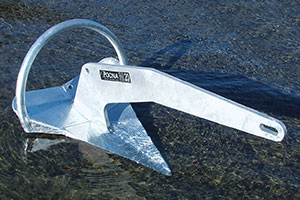
The roll-bar, the most obvious feature upon first glance, allows the lack of a dedicated weight in the toe of the fluke, and is a superior alternative to this inefficient ballast. When experimenting on the Rocna prototypes, early attempts were similar to the “budget Spade” Sword and Raya anchor types now being marketed, lacking both the roll-bar and a ballasted tip, but these concepts proved unreliable and unacceptable when tested thoroughly. Plows on the other hand invariably have some such tip-weight. Some commentators incorrectly assume that a high tip-weight is required to push the tip into the seabed, quoting specifications such as what percentage of the total weight of the anchor rests on the tip when in a setting attitude. The reality is that forces in the form of torque effected in the anchor in response to the rode, as your boat pulls on it, are far more important than the relatively small amount of weight force present. Your anchor does not set itself when it is resting on the seabed, with no force on the rode. It is only as it starts moving that the toe begins to cut in, and, in the case of the Rocna, the mounting resistance on the fluke combined with upward resistance on the skids (mounted on the back of the fluke) twists the anchor upright as it sets.
“I’ve used most types of anchor – CQR, Bruce, Danforth, Fisherman etc… I was most frustrated with the CQR, even though ours was oversize for the boat. In the hard, fine sand of the Isles of Scilly I came the closest I have ever come to losing a boat, when our CQR dragged in 60 knot gusts. Many, many times I cursed the thing when trying to get it to bite in any anchorage where there was weed present. So when the new generation of anchors came along I was ready to give one a try, and plumped for the Rocna… and I have to say it has proved (over the last two seasons) worth every penny. Not only does it set instantly like a car’s handbrake and hold like a rock, but, remarkably it does so in such a wide variety of substrates. It really is the best piece of kit I’ve bought in recent years.” — Colin Speedie, of the UK Wildlife Trusts, writing on Attainable Adventure Cruising. Colin has little time for the traditionalist mindset. “British yachties are very conservative – most of them will not hear a word against the good old CQR. But… most people who sail ‘outside the box’ a little wouldn’t have a CQR as a main anchor these days, any more than they would want to fly across the Atlantic in a biplane. I am convinced of one thing – anyone who ever tries one of the new generation of anchors will not be going back to their old CQR in a hurry.”
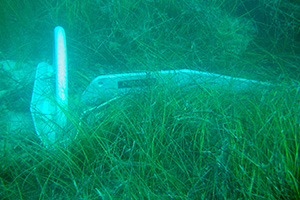
Released to the market in 2004, the Rocna for one has had a few years to clock up independent testing results and real world feedback. The former has been accomplished in its most significant form by the 2006 West Marine testing of 14 different anchor types on three different sea-beds, conducted by the US retailer and both monitored and reported on by SAIL and Yachting Monthly. The Rocna scored the highest average holding power by far, some 40% in excess of its nearest competitor, the Spade. The testers commented briefly that the Rocna exhibited “superb, consistent performance. Held a minimum of 4,500 lb and engaged immediately.” Yet more varied feedback is available from myriad boaters in all areas of the world, universally positive and particularly so when the feedback is in the form of comparisons with old generation anchors.
“Isn’t it time we looked seriously at the claims of a new generation?” ponder Yachting Monthly in their 2006 anchor testing write-up. They conclude: “The new generation of ‘roll-bar’ type anchors were a revelation… truly impressive performers – especially the New Zealand Rocna.” And more on the Rocna: “A powerful, impressive performer in our tests, recording instant sets at multiple 5,000 lb maximum pulls at 5:1 scope. On the second pull… it released at maximum tension when revs were reduced, only to reset instantly at 4,300 lb of resistance, which was astonishing for an instant set… A consistent top performer.”
Fewer vessels will find themselves in trouble as these new anchors become more widely seen on bows. The author, together with his wife, has done 20,000 NM now on his 50 kg (110 lb) Rocna prototype, including a circumnavigation of New Zealand, several years in Chilean Patagonia, and a cruise of the Antarctic Peninsula, often in extreme weather – hundreds of sets, and it never dragged when properly set, nor was it ever required to be set more than once. The Bügel is very popular amongst cruisers in the Mediterranean. The Spade has an excellent reputation worldwide. American cruising guru Steve Dashew is using a Rocna on his motor yacht Wind Horse and after a semi-circumnavigation from New Zealand to Norway via Alaska and Greenland reports it to be “better than any anchor we have used in the past”. At an ongoing online survey, nearly 30% of respondents choose the Rocna in response to the question of which one type of anchor they would prefer for a world cruise, with the historically popular CQR running second at less than 20%. The trend behind these changes is a welcome one, and fellow cruisers should be encouraged to also consider upgrading their old generation hooks – or at least consider adding a new generation type to their inventory.
The failings of the older designs no longer need be tolerated, as the technology of anchors has simply evolved that little bit further. Far superior, and safer, anchoring performance may be expected. Of course there are, and will be, the inevitable variations and copies, which add gimmicks as sales ploys or take shortcuts to cut costs but do little to further the technology. With care however, and sensible consumer awareness, the new generation anchors can mean the old cliché that ‘newer is better’ is, for once, true. That means better anchoring. And that means better cruising.
About the Author
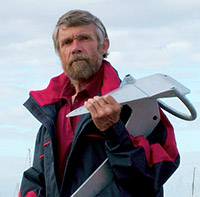
Peter Smith is the original cruiser. He sailed competitively in his early days, as well as founding successful New Zealand production boat-building firm Cavalier Yachts in the 60s. He and wife Josephine left New Zealand in 1978 to go cruising onboard Apteryx, a Cavalier 39.
A professional yachtsman and boat builder, Peter is cruising on his own custom designed and built 15.5 m (52′) aluminium sloop Kiwi Roa. He has spent forty years engaged in professional sailing, yacht deliveries, and boat building all over the world, including 10 years of running his own yard in Colchester, England – where Kiwi Roa was built.
Kiwi Roa is currently doing her thing east-about this time, starting with Chile, Patagonia, and Antarctica. In the meantime, Peter’s Rocna and Vulcan anchor designs have been developed commercially, targeted at those who want secure and reliable anchoring.
More insight to Peter can be found online at PeterSmith.net.nz, with a fuller biography published in the form of the “About Peter” page. Further discussion about Peter’s anchor philosophy and design can be discovered both here at the “Anchors and Anchoring” section, and at the Rocna Anchors Knowledge Base, which contains a wide range of information and articles on anchoring topics. More information about the Rocna and Vulcan anchors is available at the Rocna Anchors website.
References
- “The Power to Hold” Betsy Holman and Miles Clark, Cruising World May 1989
- “In Sand, the Spade and Bulwagga Rank at the Top of 15 Anchors” Editorial, Practical Sailor January 1999
- “Does It Dig In?” Adrian Faulkner, Practical Boat Owner July 1999
- “Will My Anchor Hold?” Prof. John Knox, Practical Boat Owner July and August 2002
- “How Anchors Work” Colin Thorne, Cruising Helmsman September 2002
- « Comparatif : 20 ancres au banc d’essai » Antoine Sézérat, Voiles et Voiliers May 2003
- “Call of the Bügel” Editorial, Practical Boat Owner March 2004
- “Holding Power” Bill Springer, SAIL October 2006
- “Ultimate Holding Power” Toby Hodges and Bill Springer, Yachting Monthly December 2006
- “Only One Anchor [Type]” Poll results, CruisersForum.com October 2007 – present
- “Anchoring in the Modern World” Colin Speedie, Attainable Adventure Cruising March 2008
